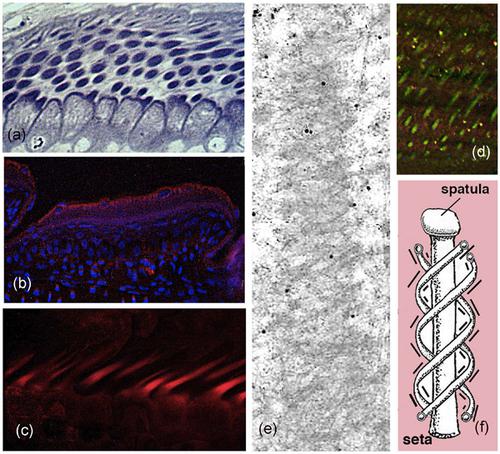当前位置:
X-MOL 学术
›
J. Exp. Zool. B Mol. Dev. Evol.
›
论文详情
Our official English website, www.x-mol.net, welcomes your feedback! (Note: you will need to create a separate account there.)
Adhesive pads of gecko and anoline lizards utilize corneous and cytoskeletal proteins for setae development and renewal.
Journal of Experimental Zoology-B: Molecular and Developmental Evolution ( IF 2.2 ) Pub Date : 2020-07-05 , DOI: 10.1002/jez.b.22976 Lorenzo Alibardi 1
Journal of Experimental Zoology-B: Molecular and Developmental Evolution ( IF 2.2 ) Pub Date : 2020-07-05 , DOI: 10.1002/jez.b.22976 Lorenzo Alibardi 1
Affiliation

|
The formation of the complex pattern of setae in adhesive pads of geckos and anoline lizards has been analyzed by ultrastructural, autoradiographic, and immunohistochemical methods. Setae terminate with spatulated ends responsible for adhesion that allow these lizards to climb vertical substrates and conquer arboreal niches. Setae derive from a complex interfaced molding between two specialized epidermal layers of the shedding complex that determines the cyclical skin molting, Oberhautchen and clear layers. Setae result from the action of setae cytoskeleton and the surrounding cytoplasm of clear cells. An intense protein synthesis, indicated by histidine and proline autoradiography, takes place during setae formation. Corneous and cytoskeletal proteins such as beta‐proteins (CBPs), intermediate filament keratins (IFKs), actin, RhoV, tubulin, plakophilin‐1, are produced during setae formation. Microfilaments of actin and microtubules of tubulin grow inside the elongating setae. Microtubules associated with filaments of unknown IKFs are produced in the cytoplasm of clear cells, forming a helical cytoskeleton that surrounds the growing setae. Oberhautchen and clear cells are tightly joined by numerous desmosomes and plakophilin‐1 is mainly localized along the perimeter of these cells. These observations suggest that actin and tubulin are present in a dynamic form in the forming setae and in the surrounding cytoplasm of clear cells. Aside the localized micro‐deformations of the cell membranes leading to setae formation the cytoskeleton determines the accumulation of CBPs inside the growing setae and the spatula. How the genome determines the specific pattern of cytoskeletal organization with the resulting species‐specific setae branching remains unknown.
中文翻译:

壁虎和苯胺蜥蜴的胶垫利用角质和细胞骨架蛋白来促进刚毛的形成和更新。
已经通过超微结构,放射自显影和免疫组织化学方法分析了壁虎和苯胺蜥蜴的粘着垫中刚毛的复杂模式的形成。刚毛的结实末端为粘连,使这些蜥蜴爬上垂直的底物并征服树栖壁ni。刚毛起源于脱落复合物的两个专门的表皮层之间的复合物界面成型物,其决定了周期性皮肤的蜕皮,Oberhautchen和透明层。刚毛是由刚毛细胞骨架和透明细胞周围细胞质的作用产生的。在刚毛形成过程中,组氨酸和脯氨酸放射自显影显示强烈的蛋白质合成。角质和细胞骨架蛋白,例如β蛋白(CBP),中间丝角蛋白(IFK),肌动蛋白,RhoV,微管蛋白,plakophilin-1是在刚毛形成期间产生的。肌动蛋白的微丝和微管蛋白的微管生长在伸长的刚毛内。在透明细胞的细胞质中会产生与未知IKF细丝相关的微管,从而形成一个围绕着刚生长的刚毛的螺旋细胞骨架。Oberhautchen和透明细胞由许多桥粒紧密结合,而plakophilin-1主要位于这些细胞的周围。这些观察结果表明肌动蛋白和微管蛋白以动态形式存在于形成的刚毛和透明细胞的周围细胞质中。除了局部细胞膜的微变形导致刚毛形成之外,细胞骨架还决定了生长中的刚毛和刮刀内CBP的积累。
更新日期:2020-08-19
中文翻译:

壁虎和苯胺蜥蜴的胶垫利用角质和细胞骨架蛋白来促进刚毛的形成和更新。
已经通过超微结构,放射自显影和免疫组织化学方法分析了壁虎和苯胺蜥蜴的粘着垫中刚毛的复杂模式的形成。刚毛的结实末端为粘连,使这些蜥蜴爬上垂直的底物并征服树栖壁ni。刚毛起源于脱落复合物的两个专门的表皮层之间的复合物界面成型物,其决定了周期性皮肤的蜕皮,Oberhautchen和透明层。刚毛是由刚毛细胞骨架和透明细胞周围细胞质的作用产生的。在刚毛形成过程中,组氨酸和脯氨酸放射自显影显示强烈的蛋白质合成。角质和细胞骨架蛋白,例如β蛋白(CBP),中间丝角蛋白(IFK),肌动蛋白,RhoV,微管蛋白,plakophilin-1是在刚毛形成期间产生的。肌动蛋白的微丝和微管蛋白的微管生长在伸长的刚毛内。在透明细胞的细胞质中会产生与未知IKF细丝相关的微管,从而形成一个围绕着刚生长的刚毛的螺旋细胞骨架。Oberhautchen和透明细胞由许多桥粒紧密结合,而plakophilin-1主要位于这些细胞的周围。这些观察结果表明肌动蛋白和微管蛋白以动态形式存在于形成的刚毛和透明细胞的周围细胞质中。除了局部细胞膜的微变形导致刚毛形成之外,细胞骨架还决定了生长中的刚毛和刮刀内CBP的积累。



























 京公网安备 11010802027423号
京公网安备 11010802027423号